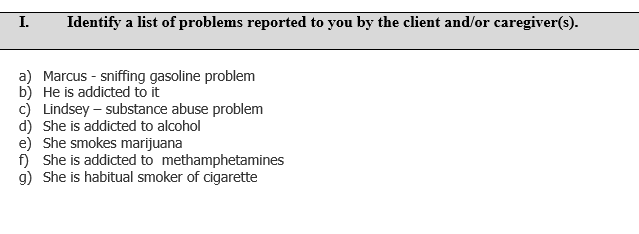Substance Abuse Interventions
Assignment: Substance Abuse Interventions
Substance use is another common problem among many adolescents. An important consideration is severity of use—mild, moderate, or severe—which helps clinicians distinguish reductions or increases in frequency of use, as well as potential physiological impacts. For example, an adolescent might drink alcohol every weekend to the point of intoxication but not become chemically dependent. An adolescent who is using heroin on a daily basis is likely to develop a physiological dependency on the drug, and to require detoxification as part of the treatment process. Treatment for any level of severity can be a long process, and there are several things to consider. First, treatments must be individualized to meet the needs of the child or adolescent. Second, treatment needs to be accessible and address an array of issues beyond just the substance abuse. For example, an adolescent trauma survivor might be using substances as a coping mechanism. In order to maintain sobriety, the trauma issues must be addressed. Third, clinicians must continually monitor and update treatment plans, monitor for changes in substance use frequency and amount, and facilitate both individual and group counseling. Fourth, a child or adolescent must stay in treatment for an extended period of time, whether it is outpatient or inpatient. Treating substance use takes time, particularly if the child or adolescent does not believe he or she has a problem. Finally, substance use treatment should include monitoring of medical conditions such as infectious diseases, as many adolescents tend to become promiscuous when using substances. Keep in mind that recovery from substance use is a lifelong process. Relapse rates are very high for adolescents, and it is important to encourage them to engage in a lifelong commitment of sobriety.
For this Assignment, select one of the substance use case studies (Case Study 3 or Case Study 4) located in this week’s resources. Consider a treatment plan, including a diagnosis, intervention, and prevention technique for the child or adolescent. Think about how you might include the parents/guardians in the treatment plan.
The Assignment:
Select one substance use case study (Case Study 3 or Case Study 4).
Complete the Treatment Plan Guidelines template provided in this week’s required resources based on the case that you selected.
Week 9: Case 3, Substance Use Marcus is a 15-year-old boy who was seen 2 weeks previously in the emergency room for a huffing incident. While his parents were away and after Marcus had mowed the lawn, he put the lawn mower and gasoline back into the shed and began sniffing gasoline. His parents came home and discovered him passed out in the shed next to the gasoline can and immediately transported him to the hospital emergency room. Marcus was treated and released, and his parents were concerned, but Marcus insisted this was a one-time incident. However, the next week his parents found several aerosol cans in their son’s room. During his first session, Marcus admits to sneaking around and huffing whatever he can whenever he can. He reports feeling out of control. He says he loves the instant high and cannot help himself. Week 9: Case 4, Substance Use Lindsey is a 12-year-old white female referred to counseling for substance abuse problems. Lindsey lives in a foster home. She was removed from her mother and stepfather’s home at age 7, when the federal authorities conducted a raid and discovered a methamphetamine lab in the home. Lindsey and her foster mother report that Lindsey initially was given alcohol by her mother and stepfather at age 4. She began smoking cigarettes at age 7, just before the police raid. Lindsey was returned to her mother’s care at age 9. She began smoking pot shortly thereafter. At age 11, she tried methamphetamines and cocaine, had a bad experience, and ended up hospitalized and, once again, removed from her mother’s care. She is now in permanent foster care. The foster mother is very concerned about Lindsey’s well-being. Although there have not been any incidents of methamphetamine or cocaine use, Lindsey has been caught smoking cigarettes and pot on several occasions. Lindsey was also caught at school selling a small amount of pot and sent to the local juvenile drug court. The drug court referred her for counseling. When you meet with Lindsey alone, she insists that pot is not a problem. She refers to it as an “herb” and as “all natural.” She says she would never go down the road that he mother went down but that pot is different and it just keeps her mellow and out of trouble. She claims that pot is her medicine and that she needs it to function at home and at school.
